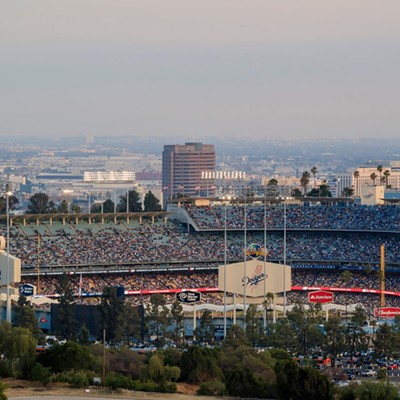8:46 a.m. Eastern Daylight Time. A hijacked passenger jet, American Airlines Flight 11, out of Boston, crashes into the north tower of the World Trade Center, tearing a gaping hole in the building and setting it afire.
Robin Snyder was disappointed that she was going to have to spend almost all of that day indoors.
"It was a beautiful day: bright blue sky, sun shining, no clouds. In Philadelphia, it's one of those late-summer days that you just want to hold onto. Now, of course, it's a day that you can't let go of."
Snyder, who now works in finance in Tucson, was then an ad executive for WTXF-TV, the Fox affiliate in Philadelphia. The station's headquarters are downtown, a couple of blocks from Independence Hall and about three blocks from the Liberty Bell. She and her co-workers were making their way into a meeting room for the regular Tuesday-morning gathering. "It was just before 9 when it came on the big-screen TV on the wall. I'm sure that just about everybody in America had the exact same reaction when they first saw what was happening.
"The first tower had already been hit and was burning. Then we watched on live TV as the second plane came in."
9:03 a.m. A second hijacked airliner, United Airlines Flight 175, also out of Boston, crashes into the south tower of the World Trade Center and explodes. Both buildings are burning.
Alan Moghaddam was a sophomore at BASIS charter school in midtown Tucson. He lived with his parents and sister out in Vail, so he had to get up early in order to make it to school on time. When he woke up that morning, his parents—Iranian immigrants who had come to the United States during the trouble over the Shah and had become successful businesspeople, first in Houston and then in Tucson—were already watching the news. He watched for a few minutes and then went back to his room to get ready for school.
"I didn't give a second thought to going to school. I mean, BASIS is basically a nerd factory. I knew the kids would be talking about it, but I didn't expect some emotional upheaval. You know, there are AP tests to study for," he says, with only the slightest hint of sarcasm in his voice.
Moghaddam had attended a public, non-charter middle school before enrolling at BASIS. It was sometime between the sixth- and eighth-grades that he stopped trying to explain to other kids the difference between Iranians and other Middle Easterners.
"Obviously, I know the difference between a Persian and an Arab," he explains, "and that some Persians have this snob thing going on. I just know that there are cultural and historical differences, which are significant to some, and completely unimportant to others, but trying to explain that to other kids is like me trying to correctly identify all of the different aliens in the bar scene in Star Wars. After a while, I just gave up."
Currently working on a doctorate in molecular biophysics at the University of Oregon, Moghaddam has a clear recollection of his thought processes that day. "I swear, when I saw those planes being flown into those buildings, I thought it was being done by crazy white people."
He had been living in Houston during the Waco standoff between federal agents and (choose one): a. heavily armed religious zealots; b. child molesters; or c. patriotic gun enthusiasts. He also remembers the bombing of the Oklahoma City federal building, although he was a little kid at the time.
"Plus, it had only been a couple of years since (Dylan) Klebold and (Eric) Harris had shot up Columbine High School. When I saw that second plane go into the building, I honestly thought, 'Wow, the crazy white people have taken things to a whole new level.'
"As the day wore on, and it became increasingly clear that it was the work of Islamic extremists, a couple of my classmates asked me if I was worried about the way some people would react. I remember thinking that I would have to dust off my old 'I'm not an Arab' routine, but I didn't really think that people would be in the mood to listen."
As it turned out, Moghaddam had nothing to worry about.
"I didn't get hassled by anybody—not students, not faculty, not by people in public places. It was kinda surprising, but nice."
9:17 a.m. The Federal Aviation Administration shuts down all New York City-area airports.
9:37 a.m. American Airlines Flight 77, which had left Washington, D.C.'s Dulles airport, crashes into the Pentagon.
9:45 a.m. The FAA halts all flight operations at U.S. airports.
On Sept. 11, Seth Holzman, who currently co-owns the wildly popular Guadalajara Grill restaurants in Tucson, was living in Sitka, Alaska, where he ran his own travel agency. He had flown out the day before to Ketchikan, at the far southern tip of Alaska's panhandle, on business. Most of Alaska sits in a time zone that's four hours earlier than the East Coast, so by the time he got up that morning, much of the bad stuff had already happened.
"It was pretty clear that it was all happening on the East Coast. Alaskans are Americans and (react accordingly), but people in Alaska are also obviously aware of the geographic realities of things. I don't think a whole lot of people in Alaska were worried about terrorist attacks in their part of the country."
When the FAA shut down all air traffic, Holzman knew there was going to be a mess. "Air travel is absolutely vital to Alaskans. That's how they get around up there."
More than 40 percent of all Alaskans live in the consolidated city-borough known as the Municipality of Anchorage, on the southern edge of the large mass of the state. But the state capital, Juneau, is on the panhandle, so people doing official business need to fly there or go by boat across the often-rough Gulf of Alaska. If one wants to make that drive (some of which must be done via ferry), it will take nearly 24 hours, a significant portion of which is spent in a foreign country, as the Alaska Highway (also known as the ALCAN Highway) leaves Alaska and cuts through the Yukon Territory of Canada before dipping back into Alaska.
"I knew right away that it was going to be a huge mess for Alaskans. Even if air travel were curtailed for a couple of days (air travel resumed three days later, on Sept. 14), it would be a major mess. I had to get back to Sitka, not just for my family, but also for my business. I knew there was going to be a lot of work."
There were scattered reports of some Alaskans—self-sufficient and ornery bunch that they are—defying the FAA's no-fly edict, but for the most part, the skies over Alaska were eerily clear of airplanes, save those of the military, just as in the rest of country.
In Washington state, a plane that was carrying a human heart for an organ-transplant group that had received special permission from the FAA was forced down by Navy F/A-18 fighters in Bellingham, about 80 miles short of its intended landing site in Seattle. After some bureaucratic wrangling, the plane remained grounded, and the heart continued its journey by helicopter.
"A lot of people wanted—needed!—to fly, but the FAA said no. I caught a ride on a ferry from Ketchikan back to Sitka." (Both Ketchikan and Sitka are on islands.)
While most Americans would spend much of the next couple of days in front of a TV set, Holzman was at his computer, working on contingencies for when the no-fly edict was lifted.
"Despite the nerves and everything," he says, "people were really good about things. They understood. And when the no-fly order was lifted, things got back to normal pretty quickly. But there was this one thing ...
"For a while after people started flying again, a lot of married couples wouldn't fly together. The husband would fly out in the morning, and the wife in the afternoon, or vice versa. It was like an unspoken thing that the bloodline wouldn't end in one instant."
9:59 a.m. The south tower of the World Trade Center (the one that was hit second) collapses. A massive cloud of dust and debris forms and spreads outward, turning day into night in nearby streets.
Award-winning history teacher Mitch Dorson knew that day would be like no other when he walked into his classroom at Catalina Foothills High School.
"I made the decision early on that we would just go about our business the best we could. I had three AP U.S. history classes in the morning, and we just followed the normal routine. But after lunch, I had AP government classes, and I decided to try something else.
"Six days before his death, Adlai Stevenson gave a speech in which he talked about 'Spaceship Earth.'" (The phrase was probably based on a passage in the 1879 work by Henry George entitled Progress and Poverty. Buckminster Fuller, creator of the geodesic dome, also used the phrase in his 1968 book Operating Manual for Spaceship Earth.)
"In the speech, Stevenson said, 'We travel together, passengers on a little spaceship, dependent on its vulnerable reserves of air and soil.' He was talking about the great disparity on this planet between the haves and the have-nots and the way we consume resources," Dorson explains.
"I probably could have gotten in trouble; some people would have suggested that I was trying to justify the actions that took place that day. But there's a big difference between trying to understand somebody's actions and actually justifying them."
10:03 a.m. United Airlines Flight 93, which had taken off from Newark, N.J., before being hijacked, crashes in Pennsylvania, near the small town of Shanksville.
10:28 a.m. The World Trade Center's north tower collapses from the top down, pancaking one floor after another as it does so.
Robin Snyder knew that she had to get out of downtown Philadelphia. Military personnel were protecting Independence Hall and the Liberty Bell, which Snyder, to this day, thinks would have been prime targets for terrorists.
"We knew about the World Trade Center; we knew about the Pentagon; and we knew about the plane crash outside of Pittsburgh, although we weren't really sure about, 'Why Pittsburgh?'" (It would later be learned that the plane had been turned around, with a likely target being either the White House or the U.S. Capitol.)
"I just kept having this horrible thought. I wondered why they didn't fly a plane into the Statue of Liberty. There wouldn't have been the horrible loss of life, but the image would have been unbearable for most Americans. I can't imagine that they knew those buildings were going to fall; they probably thought they would just do some damage. At the same time, I was worried about the Liberty Bell."
10:53 a.m. New York's primary elections, scheduled for that day, are postponed.
Snyder's husband's brother was working in Manhattan, and she tried in vain to get him on the phone. "You couldn't get anybody on the phone. Honestly, I don't know what it was; I suppose everything was just overloaded, but I don't think I got anybody on the phone that entire day." (The next day, they found out that her brother-in-law was OK.)
Snyder left work and drove to pick up her daughter, Olivia, who was in the first-grade at the time. "It was so strange. You know how they have that sign-out sheet at the office, the one with the student's name, time and reason for leaving? It'll usually say 'dentist appointment' or 'flu.' This one had several sheets of names, and the reason given for every kid was 'terror attack.'"
The next day, she drove about 50 miles up the Jersey Turnpike to a vantage point where she could see the southern tip of Manhattan. The cloud of smoke and debris was still hanging over the island.
"It was horrible. Just horrible."
12:30 p.m. The FAA reports that 50 flights are still in the air, but none of them are reporting any trouble.
Amphitheater High School football coach Vern Friedli was in the weight room that is located under the home stands at Friedli Field, named in honor of the winningest football coach in Arizona history. For the coach, it was just another day in another season, but for the man, Sept. 11 should have been special, for it was his birthday.
His wife, Sharon, remembers, "Obviously, his birthday has always fallen during football season, so we generally don't celebrate on that day. A successful coach has a routine, and the whole family is part of that routine. We'll go out to eat the weekend before or the weekend after his birthday, or on his birthday if it falls on the weekend."
Sharon Friedli owns her own insurance agency. She called her husband to let him know what was going on and then went home and spent the rest of the day in front of the TV.
He held football practice and then joined his wife at home, spending his birthday watching countless replays of passenger planes being flown into buildings.
5:20 p.m. The 47-story Building 7 of the World Trade Center complex collapses. The building had been badly damaged when the Twin Towers collapsed earlier in the day.
After writing early that afternoon, I got a call from a friend who asked if I could umpire a middle school softball game that day. I said I would, and I went into the garage to dig out my stuff. As I stood on the field at Marana Middle School, I noticed that the sky was as blue as it had been over Manhattan that morning, without a hint of monsoon activity. It was quite clear that the argument played out countless times across the country had been won by: "The best way to show what America is would be to go about our daily business."
I umpired the game; the kids had fun, and hardly any of the parents in the stands argued with any of my calls. I found out later that the guy whose place I took had been forbidden by his wife to leave the house.
She was afraid that there would be a terrorist attack ... in Marana.
10:45 p.m. New York City police believe that there are still people alive in the buildings adjacent to the fallen World Trade Center buildings.
Curtis McCrary, a longtime Tucson Weekly contributor who now runs the Rialto Theatre, was heading downtown toward that venue. He had written an advance article for the Weekly on G. Love and Special Sauce, a band with a sound that's hard to pin down. (At different times, their music has been called "slacker-rap," "alternative hip-hop" and "laid-back blues.")
McCrary wasn't sure what was going to happen. Downtown Tucson was pretty much deserted that night; of course, that's the case on most Tuesday nights.
As it turns out, G. Love was at the Rialto, but because of the ban on air travel, the members of Special Sauce had gotten stranded in San Francisco. Under the circumstances, there was really nothing to do but cancel the show and give refunds to ticket holders.
McCrary had the option of heading down to the other end of Toole Avenue, where Solar Culture was hosting a concert featuring Sleepytime Gorilla Museum.
Not really sure what was going to happen, about 75 or 80 people, including McCrary, showed up at the Rialto, just in case. They wandered into the building, filling up the lobby. G. Love appeared, guitar in hand, and stood at the top of the lobby, near the bar.
"He just began playing," McCrary recalls. "He played an acoustic set. It was solemn and respectful. There was just this sense of ... together.
"It was a special night."











